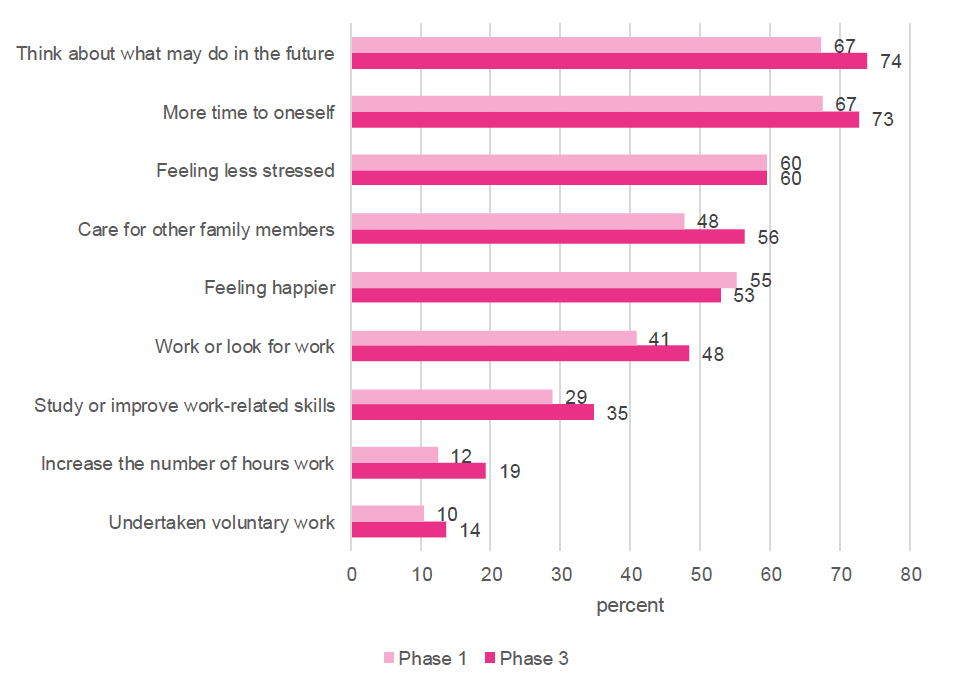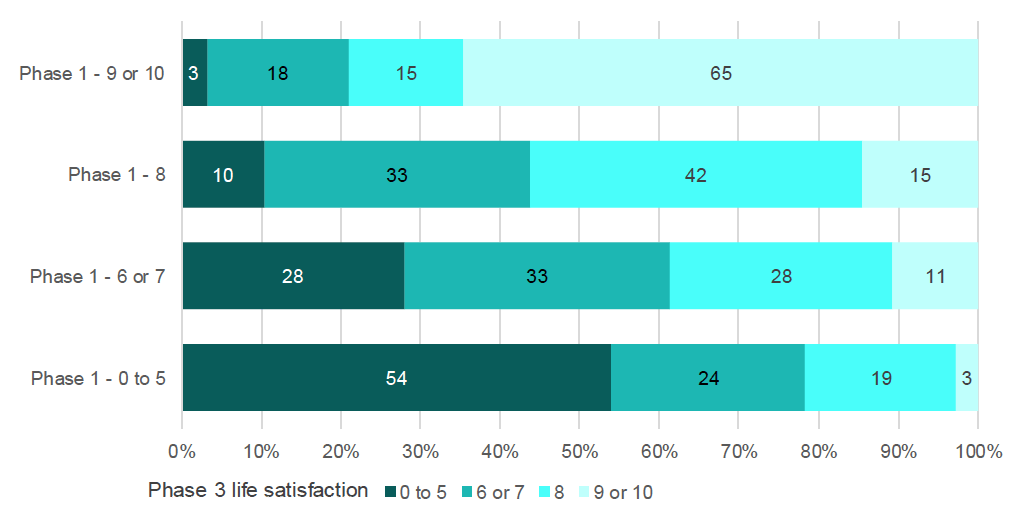Scottish Study of Early Learning and Childcare: Three-year-olds (Phase 3) Report - Updated 2021
Findings from the third phase of the Scottish Study of Early Learning and Childcare (SSELC), a research project established to evaluate the expansion of early learning and childcare in Scotland.
Parent outcomes
Economic activity
A second key strand to the ELC expansion programme is to enable parents to take up opportunities for work, study or training. Table 2 shows how the economic activities of parents have changed following a year of funded ELC.
| Phase 1 | Phase 3 | |
|---|---|---|
| % | % | |
| Working 30 or more hours a week (including if on leave or sick) | 10 | 8 |
| Working fewer than 30 hours a week (including if on leave or sick) | 25 | 33 |
| On maternity/parental leave from an employer | 2 | 2 |
| Looking after home or family | 72 | 63 |
| Waiting to take up paid work already obtained | 0 | 2 |
| Out of work and looking for a job | 8 | 9 |
| Out of work because of long term sickness or disability | 11 | 10 |
| On a Government training or employment scheme | 1 | - |
| In full time education (including on vacation) | 5 | 5 |
| In part time education (including on vacation) | 1 | 3 |
| Wholly retired | 1 | 1 |
| Not in paid work for some other reason | 10 | 9 |
| Unweighted base | 221 | 221 |
Base: All respondents (with parent questionnaire at both Phase 1 and Phase 3, unweighted)
Table 2 shows that there is little change over the course of a year in terms of economic activity for parents and carers of children who were eligible for funded nursery places at the age of two. There was a small increase in the proportion who reported working part time, from 25% at Phase 1 to 33% at Phase 3, with the proportion in either part-time or full-time work increasing from 35% to 40%. There was also a corresponding drop in the proportion who reported looking after the home or family, from 72% to 63%. Of those who were in work or training at Phase 1, most (88%) remained in work at Phase 3. Similarly, most (83%) of those who were not in work at Phase 1 were not in work at Phase 3, while one in six (17%) of those who were not in work at Phase 1 had since found employment.
Those who were in work were asked at each phase whether they would work more hours if they could find good quality, affordable childcare. Just over half (55%) of those who were in employment at both phases agreed with this statement at Phase 3, an increase from Phase 1 (42%). A similar question was asked of those who were not in employment: whether a lack of affordable, good quality childcare is one of the main reasons for them not working. Smaller proportions of those not in employment at both phases agreed with this statement: 27% at Phase 3 and 32% at Phase 1.
Parental health and wellbeing
At both phases, parents were asked what they had been able to do because their child was in nursery. Responses are summarised in Figure 14.

Base: All respondents (with parent questionnaire at both Phase 1 and Phase 3, unweighted)
Figure 14: Agreement with statements reflecting activities done / perceived change in feelings because of child being in nursery, Phase 1 and Phase 3 Description. This bar chart shows whether parents agreed or disagreed with statements reflecting activities done / perceived change in feelings because of their child being in nursery at Phase 1 and Phase 3.
Responses at Phase 3 tended to be very similar to those at Phase 1, with small increases in the proportion in agreement with some of the statements. Around three quarters of parents at Phase 3 agreed with the statements that they had been able to think about what they may do in the future (74%) and that they had more time to themselves (73%), in both cases up from 67% at Phase 1. The majority at Phase 3 were also feeling less stressed (60% at both Phase 1 and Phase 3), able to care for other family members (48% at Phase 1 and 56% at Phase 3), feeling happier (55% at Phase 1 and 53% at Phase 3). Smaller proportions agreed with the statements concerning work-related activities, but in each case these represented a small increase across the year from Phase 1 to Phase 3. Half (48%) agreed they had been able to work or look for work because their child was in nursery, up from 41% at Phase 1, and a third (35%) agreed they had been able to study or improve work-related skills, up from 29% at Phase 1.
At both phases, parents were asked, on a scale of 0 to 10, how satisfied they were with their lives as a whole nowadays. Despite the generally positive findings above, 22% of parents rated their lives no more than 5 out of 10 at Phase 3, up from 17% at Phase 1. Figure 15 shows how levels of life satisfaction had changed over time for individual parents. Two thirds (65%) of those who appeared most satisfied with their lives at Phase 1, when their child was aged two, scored themselves a 9 or 10 again one year later, at Phase 3. Just over half (54%) of those who were least satisfied with their lives at Phase 1 again scored themselves no more than 5 out of 10 at Phase 3. However, for many parents there was change in the levels of life satisfaction, which are likely to reflect changes in circumstances beyond the scope of this survey.

Base: All respondents (with parent questionnaire at both Phase 1 and Phase 3, unweighted)
Figure 15: Life satisfaction Phase 3 by life satisfaction Phase 1 Description. This stacked bar chart shows 65% of those who appeared most satisfied with their lives at Phase 1, scored themselves a 9 or 10 again at Phase 3. 54% of those who were least satisfied with their lives at Phase 1 again scored themselves no more than 5 out of 10 at Phase 3.
Finally, parents were asked how they were coping as a parent. At Phase 3, 58% said they were coping well most or all of the time, showing little change from Phase 1 (59%). A further 38% at each phase said they felt they were coping, but sometimes things got on top of them. Only 4% at Phase 3 and 3% at Phase 1 felt that most or all of the time they were not coping well (Appendix C Table C14). Again there was some movement between response categories for individual parents, but overall there was very little change following a year of nursery.
Contact
Email: socialresearch@gov.scot
There is a problem
Thanks for your feedback